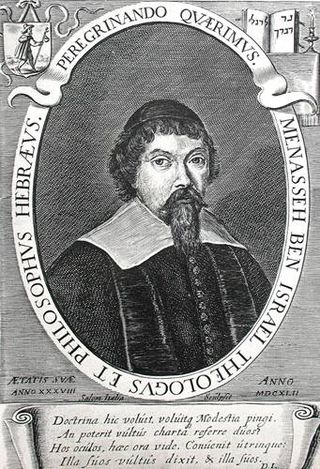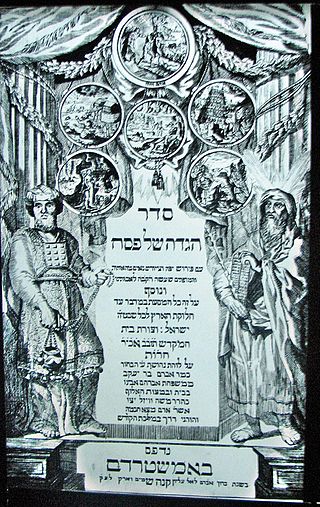Related Research Articles

Abraham ben Meir Ibn Ezra was one of the most distinguished Jewish biblical commentators and philosophers of the Middle Ages. He was born in Tudela, Taifa of Zaragoza.

The Abravanel family, also spelled as Abarbanel, Abrabanel, Avravanel, Barbernell, or Barbanel – literally meaning Ab ("father") rabban ("priest") el – is one of the oldest and most distinguished Jewish families. It first achieved prominence on the Iberian Peninsula during the Middle Ages. Its members claim to trace their origin to the biblical King David. Members of this family lived in Seville, Córdoba, Castile-Leon, and Calatayud. Seville is where its most prominent representative, Don Judah Abravanel, once dwelt.

Manoel Dias Soeiro, better known by his Hebrew name Menasseh or Menashe ben Israel, was a Jewish scholar, rabbi, kabbalist, writer, diplomat, printer, publisher, and founder of the first Hebrew printing press in Amsterdam in 1626.

The Reina–Valera is a Spanish translation of the Bible originally published in 1602 when Cipriano de Valera revised an earlier translation produced in 1569 by Casiodoro de Reina. This translation was known as the "Biblia del Oso" because the illustration on the title page showed a bear trying to reach a container of honeycombs hanging from a tree. Since that date, it has undergone various revisions, notably those of 1865, 1909, 1960, 1977, 1995,2004, 2011, and 2015.
The Christian Community Bible (CCB) is a translation of the Christian Bible in the English language originally produced in the Philippines.
Spanish and Portuguese Jews, also called Western Sephardim, Iberian Jews, or Peninsular Jews, are a distinctive sub-group of Sephardic Jews who are largely descended from Jews who lived as New Christians in the Iberian Peninsula during the few centuries following the forced expulsion of unconverted Jews from Spain in 1492 and from Portugal in 1497. They should therefore be distinguished both from the descendants of those expelled in 1492 and from the present-day Jewish communities of Spain and Portugal.

The Benveniste family is an old, noble, wealthy, and scholarly Sephardic Jewish family of Narbonne, France, and northern Spain established in the 11th century. The family was present in the 11th to the 15th centuries in Hachmei Provence, France, Barcelona, Aragon, and Castile.

Joseph Athias was a merchant, bookprinter and the publisher of a famous Hebrew Bible which was approved by States-General of the Dutch Republic and both Jewish and Christian theologians.
Gracia Mendes Nasi, also known as Doña Gracia or La Señora, was a Portuguese Jewish philanthropist, businesswoman, and one of the wealthiest women of Renaissance Europe. She married Francisco Mendes. She was the maternal aunt and business partner of João Micas, who became a prominent figure in the politics of the Ottoman Empire. She developed an escape network that saved hundreds of conversos from the Inquisition.

Casiodoro de Reina or de Reyna was a Spanish theologian who translated the Bible into Spanish.

The Ferrara Bible was a 1553 publication of a Judeo-Spanish version of the Hebrew Bible used by Sephardi Jews. It was paid for and made by Yom-Tob ben Levi Athias and Abraham Usque, and was dedicated to Ercole II d'Este, Duke of Ferrara. Ercole's wife Renée of France was a Protestant and a daughter of Louis XII.

Moses Gaster was a Romanian, later British scholar, the Hakham of the Spanish and Portuguese Jewish congregation, London, and a Hebrew and Romanian linguist. Moses Gaster was an active Zionist in Romania as well as in England, where in 1899 he helped establish the English Zionist Federation.
Several Spanish translations of the Bible have been made since approximately 700 years ago.

The Alba Bible also known as the Arragel Bible, was created to foster understanding between Christians and Jews. It is an illuminated manuscript containing a translation of the Old Testament made directly from Hebrew into mediaeval Castilian. The translation was completed under the supervision of Moses Arragel, who was rabbi of the Jewish community of Maqueda in the Spanish province of Toledo. This was done at the request of Grand Master Luis González de Guzmán of the Order of Calatrava. During the antisemitic riots of 1430, the Alba Bible was created. Arragel initially hesitated due to the unrest, but ultimately chose to assist Guzman in translating and interpreting the manuscript. This collaborative process lasted eight years, from 1422-1430.
Jewish printers were quick to take advantages of the printing press in publishing the Hebrew Bible. While for synagogue services written scrolls were used, the printing press was very soon called into service to provide copies of the Hebrew Bible for private use. All the editions published before the Complutensian Polyglot were edited by Jews; but afterwards, and because of the increased interest excited in the Bible by the Reformation, the work was taken up by Christian scholars and printers; and the editions published by Jews after this time were largely influenced by these Christian publications. It is not possible in the present article to enumerate all the editions, whole or partial, of the Hebrew text. This account is devoted mainly to the incunabula.

Although the biblical themes have been an essential formative substance of the Portuguese culture, composition in that language of a complete translation of the Bible is quite late when compared with other European languages. The beginnings of the written transmission of the sacred text in Portuguese, parallel to its traditional liturgical use in Latin, are related to the progressive social acceptance of the vernacular as a language of culture in the low-medieval period. And even though the official language of the Portuguese monarchy dates back to the end of the thirteenth century, during the reign of D. Dinis, the writer Carolina Michaëlis de Vasconcelos (1851–1925), for example, was able to state categorically that, in the medieval period, "Portuguese literature, in matters of biblical translations, is a poverty Desperate" – a judgment that remains valid, experts say.

Samuel Usque was a Portuguese converso Jewish author who settled in Ferrara. Usque was a trader.
The initiator of Esperanto, L. L. Zamenhof, translated the entire Hebrew Bible into Esperanto. His translation has been much admired by Esperantists and is widely held up as a model or exemplar for other Esperanto authors and translators. Other translators have also edited and published Esperanto versions of the New Testament and Apocrypha.

Abraham ben Mordecai Farissol was a Jewish-Italian geographer, cosmographer, scribe, and polemicist. He was the first Hebrew writer to deal in detail with the newly-discovered Americas.
References
 This article incorporates text from a publication now in the public domain : Aikin, John (1815). General Biography. Ten volumes.
This article incorporates text from a publication now in the public domain : Aikin, John (1815). General Biography. Ten volumes.